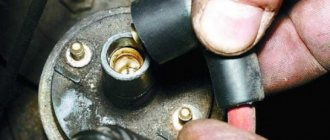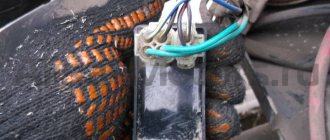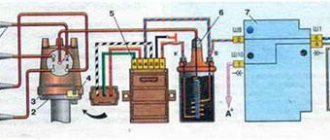When should you check spark plugs?
There are several situations in which the driver should think about the condition of this engine component. The machine must be placed in the hands of qualified technicians in the following situations:
- When the manufacturer's recommended service life expires. Experienced craftsmen can check whether there is a spark on the spark plugs and test it in a working situation;
- Difficulty starting the car - the car starts with great difficulty, and in the cold season it may not start at all;
- Unstable operation at idle - the engine stalls when idle at traffic lights.
If necessary, you can carry out all the necessary procedures yourself; for this you just need to know how to check the spark plugs.
How to check the spark on a fuel-injected engine
One of the most important parts of your car's electrical system is the spark plugs.
These parts ignite the fuel, and if the spark plugs stop working properly, the engine will experience certain problems. The spark plugs themselves do not break so often; most likely, other factors are to blame for the lack of a spark. However, sometimes a candle that has already exhausted its service life cannot properly perform its working functions. Therefore, it is advisable for every driver to know how to check spark plugs on the road without special tools and diagnostic equipment. The best way to check spark plugs is through timely maintenance and regular servicing of the machine. The first symptoms of faulty spark plugs and lack of spark
The reasons for the failure of spark plugs in a car can be very different. But the symptoms are similar in most cases. The main indicator of the failure of one spark plug is that the engine begins to stall. When such an unpleasant aspect occurs, the power of the unit decreases, consumption increases, and the car shakes a little at idle. All this allows us to conclude that one of the cylinders is not working, in particular because there is no spark at the spark plug. The following symptoms of non-functioning spark plugs are also distinguished:
the car does not start, when trying to start the engine the starter turns smoothly, there is no progress in the ignition; after starting, 2 or 3 cylinders work for some time, then the fourth one is connected - this is an indicator of failure of the spark plug; the car constantly became difficult to start, the engine starts only on the third try; the car has lost power and responsiveness; pressing the gas pedal does not produce the desired effect; the car stalled during the trip, starting it is difficult or even impossible; From time to time, during startup, strong pops are heard in the exhaust pipe - this is the fuel that has been pumped up but not burned.
When all the spark plugs do not work, this situation should alert the car owner. Most likely, the reason is not the spark plugs. But if one spark plug refuses to work, you should look at the spark plug itself, as well as at the wire that connects it to the coil. This will help you find out what exactly caused the problem in your car. And if testing sensors, switches and coils in the field is not an easy task, then testing spark plugs is quite possible.
How to check spark plugs without special equipment?
On the road, we often don't have any equipment to test spark plugs. Therefore, you have to make do with traditional methods to check all the subtleties of the car. In particular, in the case of candles, you can use one of the proven testing methods. First, you should unscrew the spark plug and take a closer look at it, obtaining information about its condition. If the spark plug is wet, it floods with gasoline and does not work. A dry spark plug means there is no fuel getting to it or everything is working properly. A black candle wick also indicates a problem. You can check for spark as follows:
unscrew the spark plug and put a high-voltage wire on it so that you can give a spark; grab the rubber part of the wire with your hand, but under no circumstances grab the metal parts of the spark plug; place the candle wick at a distance of about 0.5 centimeters from the engine body - any metal part; Have another person turn the ignition key and try to start the engine within four seconds; if a spark appears and penetrates the engine body, it means that everything with the spark plugs is in perfect order, you need to look for other problems; if there is no spark, the spark plug does not work, and other not very pleasant problems are also possible.
If there is a spark, then the engine starting problem is related to the fuel system. If there is no spark, the culprit of your problems is the vehicle's electrical system. These will not necessarily be spark plugs, because the electrical system of a car contains quite a few different elements that can damage the spark plug assembly. You need to check everything to fully ensure that the equipment is working properly. By the way, the easiest way to check whether the spark plugs are working is to replace them with ones that are known to work.
What else could cause the spark plugs to not spark?
If there is no spark, many drivers confidently say that they need to change the spark plugs. But this is not always true. In particular, there are other modules that can affect spark production, so you need to check all the features of the vehicle's electrical system. If we are talking about the fact that the ignition system does not produce a spark, it is necessary to pay special attention to those modules that are responsible for this spark. Among them, you will have to check and suspect a malfunction of the following important machine modules:
high-voltage wires - often this element is the reason for the lack of a spark, the wire can pierce; ignition coils or distributors on older cars are frequent candidates for replacement and repair; the switch is a part that rarely raises doubts about its operation; it breaks down not so often, but very unexpectedly; ignition switch - one of the contacts may come off and not give normal commands to the car engine; an on-board computer that controls the actions of the vehicle's electrical system, including the ignition.
How to check spark plugs yourself
You can check the presence of a spark and, in general, operability, in several ways:
- Start the engine and pull out the high-voltage wires from the spark plugs one by one. If the spark plug does not work, the sound and vibration of the internal combustion engine will not change. And, if you disconnect the wire from a working spark plug, you will immediately feel changes in the operation of the motor.
- Turn off the engine. Unscrew the spark plug, place the thread on the body, for example, on the valve cover, and a second person turns the ignition key. It is better for the person holding the candle to hold it with rubber gloves or let it go altogether. His task is to see if there is a spark, and what kind of spark it is.
- A special device for checking spark plugs is a pistol. A spark plug is inserted into the gun and it is determined whether there is a spark or not.
- A homemade device for testing candles - a piezo lighter with a wire. Connect the wire from the piezo lighter module to the removed candle and place the piezo lighter block itself on ground, then press the button on the block.
- There is also a pressure test method. But why use all sorts of complicated methods when the first two methods of checking spark plugs are the most effective.
How to check the spark
From time to time you have to check the performance of the spark plugs to find out some of the reasons for unstable operation. There are 3 ways to check spark plug sparks:
- We check for weight.
- We check with an electronic measuring instrument (multimeter).
- Manual mechanical military method of checking spark. The essence of the method is to make a gap of 4 mm. If the spark hits exactly in the middle, then this is a perfectly working spark plug. If with such a gap the spark hits the side, then this is a poorly functioning spark plug.
Signs that you need to check the spark plugs for a spark:
- interruptions at idle speed;
- engine tripping;
- twitching while moving;
- fuel consumption has increased.
Why there is no spark, reasons:
- the candles were flooded;
- broken high-voltage wires;
- contact is broken;
- The crankshaft sensor has failed;
- the ignition module has failed;
- the ignition coil (bobbin) has failed;
- the switch has failed;
- faulty distributor;
- the service life has expired (usually the service life is up to 50 thousand km);
- large layers of soot on the electrodes of the spark plugs (due to low-quality fuel and over-suction);
- presence of oil on the electrodes (excess oil and worn rings);
- varnish and slag deposits on the electrodes (due to various additives in oils and fuels);
- melted candles;
- mechanical damage to the composite spark plug;
- ground contact is poor;
- The electronic control unit (ECU) is not working correctly.
The main reasons why there is no spark
- problem with spark plugs (flooded or faulty);
- breakdown of high-voltage wires or loss of contact;
- the reason is the crankshaft sensor (requires checking with a multimeter);
- malfunction in the ignition module;
- failure of the ignition coil;
- problem in the switch;
- Distributor malfunction (burned contacts, loss of clearance);
- poor ground wire contact;
- failure or malfunction of the ECU;
Ignition coil and its structure
The mechanical operation of gasoline engines occurs as a result of the combustion of a fuel-air working mixture in the cylinders, which is ignited by an electric spark. The ignition circuits are powered by the car's on-board power supply, which for safety reasons has a 12-volt voltage, which is not enough to create a spark. The simplest way to produce high voltage is to use a step-up transformer, which is traditionally called a coil.
The transformer does not work with direct current. At the same time, a short spark is enough to ignite the mixture. To obtain it, a breaker is introduced into the ignition circuits. The current jump at the moment of operation makes it possible to carry out a transformation and remove a voltage of several kilovolts from the output of the coil, which is then supplied to the spark plugs.
The coil contains two windings: low voltage or primary and high voltage or secondary. Due to the large currents flowing in the primary winding, it is wound with a wire with a large cross-section and has a low ohmic resistance. The secondary winding transmits a small current, which allows it to be wound with a thin wire. In addition, due to the need to obtain a high transformation ratio, it contains several thousand turns. Thus, it has high resistance.
Why might there be a weak spark on the spark plugs?
A weak spark on the spark plugs is possible for the following reasons:
- replacing the electronic ignition contact coil (and vice versa), outwardly they may not differ in any way;
- high-voltage breakdown in the coil body;
- interturn short circuit in the coil;
- poor “ground” in the engine or on the car body;
- breakdown of additional resistance in the slider, individual coil;
- breakdown of high-voltage wires, the presence of cracks in them as a result of high temperatures.
The presence of a breakdown in high-voltage wires can be checked by ground by starting the engine in a completely dark garage. In this case, the “extraneous breakdown” will reveal itself visually.
Most car enthusiasts believe that the main reason for the loss of spark is a malfunction of the ignition coil. Experience shows that this is far from the case. There is a well-known driver’s saying about this: “It wasn’t about the reel, ..... I was sitting in the cab.” In order not to find yourself in the role of a careless driver, you should investigate all possible reasons for the lack of spark.
What does the P0420 error code mean and how can it be resolved.
When do you need to change spark plugs and what does it depend on?
Video - no spark on VAZ 2110, troubleshooting:
Checking the spark on the injection engine
Among the common malfunctions of an injection engine or carburetor engine is when the spark is lost on the spark plugs. In this case, the engine may not start or after starting it may function intermittently (triple), since there is no spark at one of the spark plugs and the cylinder actually does not work.
In such a situation, diagnosis should begin with checking the ignition system. In parallel with this, it is worth taking into account certain features and nuances depending on the type of engine installed. Next, we will talk about available ways to check the ignition for spark in relation to engines with a carburetor, and also consider what to do if the spark on an injection engine is lost.
Read in this article
The starter turns, but there is no spark
On the “ten” one of the problem units is the ignition module. It’s best to look for a working module from your friends and check it on your car. This is the easiest and fastest way to check. If after changing the module the engine started without problems, then the reason was hidden precisely in it. Pay attention to the chip that connects to this module; there may be no power in it. If this is indeed the case, then check the entire power supply system.
Often the spark disappears due to the fault of the DPKV. Thanks to this sensor, the operation of the cylinders is monitored. It is one of the most important elements of the ignition system. However, there is one difficulty: the operation of this unit can only be checked using an oscilloscope. It is impossible to accurately determine the functionality of this module on your own, so many car enthusiasts simply replace the sensor with a working one.
The ECU may also malfunction, in which there is no spark to ignite the fuel. For example, if this module operates incorrectly, a spark may be selectively supplied: only to the 2nd and 4th cylinders or, conversely, to the 1st and 3rd. Repairing the ECU is simple - just clean its contacts (chip) from any oxide that has appeared. It is this “plaque” that can cause spark failures.
Diagnosis
How to check the spark plugs on the injector yourself? This technique is considered one of the most common and used types of checks. In everyday life, diagnostics proceeds in the following stages:
- The elements are properly cleaned: carbon deposits and other contaminants are removed.
- Using a probe (a device for controlling the gap), the distance between the electrodes is adjusted.
- The wire is strung.
- The candle is applied to the metal side of the automobile power unit. This creates the required electrical interaction.
If you have difficulty checking using this principle, then how can you check the operation of the spark plugs on the injector? You can simply start the starter, and then the engine itself. When a blue spark immediately forms upon startup, it means everything is fine. If you get a spark with a red tint, or not at all, a replacement is needed. The spark plug spark test is now complete.
Multimeter device
How to check spark strength on the ignition module
Most car owners understand that when the engine starts to stall or has trouble starting, the problem is often a lack of spark. Therefore, checking the spark on the injector is a manipulation that should not cause any difficulty for the driver, who often has to deal with the need for repairs in the field. Naturally, you should always have a set of several new, or simply working, candles with you.
Since the lack of a spark is the most common cause of the engine stalling or difficult to start, as well as unstable idling, checking the spark on the spark plugs is carried out by motorists first. In order not to turn out all the spark plugs at once, you can check them one by one - removing one by one from the cylinder head, putting caps on them with a wire from the coil and grounding each spark plug to ground. Rotating the starter should produce a nice, bright spark. If it is missing, you can replace the wire (it is advisable to carry a spare one with you) or use one that is known to be working.
When removing high-voltage wires from the module, it makes sense to number them first - this will avoid confusion in the future. Problems caused by the spark plug or wires become obvious in this way. If a spark does not appear on the spark plug, the problem lies in the module itself. In order to accurately determine this, the “replacement” method will help - the working module can be temporarily “borrowed” from another car of the same model. If replacement fixes the problem, you can safely go to the auto store for a new one.
Checking the spark
If the engine suddenly begins to misfire, that is, to run unevenly and twitch, and other signs of problems with the spark appear (power is lost, the color of the exhaust changes), then you need to check if there is a spark. The first step is to unscrew the spark plug and visually inspect it; a light gray or brownish coating indicates normal operation of this cylinder. If there is carbon deposits on the spark plug, it means there are problems with ignition - the spark plug will have to be replaced.
You can check whether there is a spark in the cylinder without unscrewing the spark plugs. To do this, it is necessary to pull off the caps of the high-voltage wires from the spark plugs one by one while the engine is running. By pulling off the cap, we turn off this cylinder from operation, the engine should start. If nothing happens, then we have found a problem cylinder in which there is no spark.
You can check the spark the old fashioned way. You need to unscrew the spark plug, put the cap from the high-voltage wire on it and bring it to the engine housing. In this case, the assistant must start the car. If a spark appears between the spark plug contact and the motor, then it is working properly.
With any method of ignition diagnostics, you need to be extremely careful not to receive an electric shock from high-voltage wires.
Photos from Internet resources
#car service
Comments
Test drives
All test drives
Checking spark plug spark outdoors
It is important to know!
Every motorist should have a universal device for removing scratches on a car of any color. The effect is visible within 10 minutes, and the action of RENUMAX will pleasantly surprise you with its simplicity and effectiveness. Read more >>>
We unscrew the spark plug, put a high-voltage wire on it and install its base to ground (for example, the engine). We check for the presence of a spark when the starter is cranked.
It’s even better if you supplement this method with the following technique: close the gap between the electrode with a dielectric (for example, plastic). If the ignition system is working properly, the spark will jump between the central electrode and the skirt. If it is not there, then there is a crack in the spark plug insulator.
Attention! While the starter is operating, do not touch the spark plugs and tips of high-voltage wires.
Method No. 2: Spark piezoelectric probe (for example, Test-M) or lighter.
If you don’t have a ready-made device at hand, you can use an element from a piezo lighter instead. The principle of testing is similar: we connect the device to the upper contact of the spark plug and to the body. The button is pressed, if a spark jumps, then the spark plug is working; if it drips or is missing, then it is broken. Details in the video:
Method number 3: Use a multimeter. You should check the electrical circuit of the central electrode by setting the device to 20 kOhm.
If there is “contact” between the central electrode and the tip (shows resistance), then the reason for the lack of a spark may be damage to the insulator. Video example:
This is interesting: Balancing car wheels with your own hands, step-by-step instructions
Each type of candle must have its own resistance. This verification method is less accurate.
These methods work, but they cannot determine the serviceability of the spark plug 100%. For example, a spark plug installed in an engine has a bad spark, but when checked it will look like it is fully working. Why? In open air, the voltage required to form a spark is much less than in a cylinder. In the combustion chamber of an engine, a spark appears in the presence of a compressed air-combustible mixture.
If there is no spark: ignition module
The following symptoms indicate possible problems with the operation of the ignition module:
- at idle speed the engine troits;
- power decreases, the car accelerates poorly;
Engine vibration is most pronounced in two nearby cylinders, and the drop in thrust is more strongly felt during attempts to sharply accelerate the vehicle, that is, when the accelerator is pressed hard and sharply. In such a situation, the “check” light usually lights up on the dashboard of most cars.
If checking the spark plugs and high-voltage wires does not reveal any problems, then the ignition module should be checked with a tester. The test consists of connecting one output of the tester to the module connector, and powering the other to ground. Then the engine can be started. A tester reading of 12 V is evidence that the module is OK. A deviation in the instrument readings from the norm may indicate either the need to replace the module itself or to check/replace the corresponding fuses.
Checking the ignition coil for spark
To diagnose the performance of the coil, remove the wire from the distributor-breaker. Next, the test is carried out similarly to testing high-voltage wires, that is, the wire is brought to a metal surface and turned with a starter. The presence of a spark will indicate in this case a problem with the ignition distributor; if there is no spark, then the problem lies in the coil.
First you need to check the distributor contacts. These contacts may oxidize, insulation damage is also possible, and the rotor itself may be faulty. Detecting problems with the rotor allows you to eliminate the problem by replacing it. When checking the ignition coil, you should identify possible defects in the integrity of the winding, burnouts and other signs that a short circuit is occurring inside. If such signs are found, the coil should be replaced or the ignition coil should be repaired.
Now let's take a closer look at ways to check the main elements of the ignition system. To do this, let's go back to the coil. As already mentioned, the most common cause of a malfunction is a damaged winding. Then an insulation breakdown occurs and a short circuit occurs. It is also important to understand that the coil can fail due to overload. Such increased loads occur as a result of problematic spark plugs or spark plug wires. For diagnosis you should:
- put the car in a dry parking, repair or other box. You can also use the garage. The main thing is that the humidity is not too high;
- Next, you will need to clean the distributor cover from dirt, after which the specified cover must be removed;
- then you need to turn the engine crankshaft so that the distributor contacts are closed;
- Now you can turn on the ignition and bring the high-voltage wire of the distributor 3-7 mm to ground;
This is interesting: Attackers can gain access to control your car
After evaluating the spark, you can decide whether the ignition coil needs to be replaced. Please note that repairing this element is often impractical. Also, when installing a new spare part, you should strictly adhere to the required polarity. If this is not done, then the new part will quickly become unusable after unqualified installation. Please note that car service centers use a special stand to check coils. Such equipment allows you to check the coil taking into account various operating modes.
To check the spark on the spark plugs if the distributor is working properly and there are no problems with the condition of the high-voltage wires, you need to unscrew the spark plugs from the engine. In addition to the contacts, you should look at carbon deposits, the degree of oiling of the electrodes, etc. For normal sparking, contamination must be cleaned. You should also check the gap between the electrodes, which is usually between 0.7 and 0.9 mm. If the gap is broken, then you can carefully bend the side electrode. This method is a temporary measure, but in some cases it allows you to drive from several tens to hundreds of kilometers without tripping the engine in case of problems with the spark plugs.
We also add that there are special pistol devices for checking spark plugs. Typically, such solutions are available from spark plug sellers in car dealerships or automotive markets. If there is such a possibility, then the spark plugs can be checked on similar equipment.
Replacing spark plugs
There are spark plugs (SZ) and glow plugs (CH). The former are used for gasoline engines, the latter for diesel engines.
Symptoms of SZ problems:
- The internal combustion engine does not start well;
- the engine “troubles” (accelerates poorly, lacks traction and “power”);
- fuel consumption has increased;
- the share of carbon dioxide in the exhaust has increased;
- engine dynamics are reduced.
For SN the list is as follows:
- it is difficult to start the car in cold weather;
- at idle the internal combustion engine operates unevenly;
- white smoke from the exhaust pipe;
- spiral indicator failure.
Important: detection of the listed signs is indirect evidence of the need to replace the spark plugs and requires mandatory inspection.
You can replace the elements yourself or entrust it to experienced car service employees.
Cleaning candles yourself
In many cases, diagnosing a spark plug comes down to cleaning it. After all, a candle covered with soot and dirt begins to work worse and worse.
Self-cleaning takes place using the following methods:
- Manual method . No auxiliary devices are required here. It is extremely important to be careful, otherwise the electrode may be damaged. Also, sharp objects are not needed in this case. Will do: a metal brush, a toothbrush, fine-grained sandpaper.
- Application of sand . You need a container with it and a drill. A candle is placed in the last one. Its end with the electrode is placed in sand. Let's start the drill. We look at the quality of turnover (insignificant).
- Using a sandblasting machine . This method effectively removes deposits and carbon deposits. Different types of sand are used here. The operation takes place with the effect of compressed air.
- Chemical cleaning . This method helps to quickly eliminate deposits. Here, agents such as acetone, the drug (Fairy or its analogues) and vinegar are used. A composition for cleaning the carburetor or a rust remover is also suitable. Some craftsmen use Coca-Cola for cleaning. Any of these products is applied in a layer of approximately 3 mm. This lasts for about 4 minutes. Then rinse with drinking liquid. Matches or wooden sticks are used to clean the outer part.
- Application of silite . Candles are placed in a jar. This product is poured into it. After which the container is placed under hot water. This results in a chemical reaction. There is an hour wait. You can then clean the electrode with a standard toothbrush.
- Using vinegar . The candle is placed in a jar with it. Stay time – 1 hour. Then a little electrolyte is added to this composition. Next, the candle is cleaned. You can use a toothpick.
Do not diagnose spark plugs by removing the caps with the engine running. Risk of electric shock. You can also burn the coil or commutator.
Symptoms of a problem
It is almost impossible to visually determine that there are problems with the current supply in the car. To diagnose, you should start the engine or drive the equipment at high speeds.
Before checking the ignition module, you should clearly know the symptoms of the “disease”. So, the first signals about problems with spark plugs:
- The vehicle's crankshaft rotates at the required speed, but the engine does not start. Due to the lack of a spark, there is no ignition of the combustible mixture;
- alternate flashes and fires occur in one or more cylinders, and as a result the engine operates unstable and chaotically;
- The power unit operates when the car starter rotates. When the “trigger” stops rotating, the unit stalls;
- a sharp loss of the machine’s power potential and, as a consequence, increased fuel consumption;
- failure of the catalyst due to a large amount of unburned fuel inside the segment;
- a long process of starting the engine during periods of medium and low outside temperatures. At this time, a large amount of moisture collects on the outer walls, which does not allow the spark of the candle to pass through;
- all kinds of mechanical damage to the spark plug body, which leads to an unstable supply of current to the combustion chamber for ignition.
If there are pronounced black carbon deposits on the spark plug housing, this indicates a malfunction in the power and fuel supply system. Problems with ignition timing can also be caused by worn-out power system wires .
No spark on VAZ 2106
Sparking is an important process that ensures the startup and stable operation of the power unit, for which the ignition system is responsible. The latter can be contact or non-contact, but the essence of its work remains the same - to ensure the formation and distribution of a spark to the desired cylinder at a certain point in time. If this does not happen, the engine may either not start at all or run intermittently. Therefore, it is worth dwelling in more detail on what kind of spark there should be and what the reasons for its absence may be.
Why do you need a spark?
Since the VAZ 2106 and other “classics” are equipped with an internal combustion engine, the operation of which is ensured by the combustion of the fuel-air mixture, a spark is required to ignite the latter. To obtain it, the car is equipped with an ignition system, in which the main elements are spark plugs, high-voltage (HV) wires, a distributor-breaker and an ignition coil. Both spark formation as a whole and the quality of the spark depend on the performance of each of them. The principle of obtaining a spark is quite simple and comes down to the following steps:
- Contacts located in the distributor provide low voltage supply to the primary winding of the high-voltage coil.
- When the contacts open, a high voltage is indicated at the coil output.
- High-voltage voltage is supplied through the central wire to the ignition distributor, through which sparks are distributed to the cylinders.
- A spark plug is installed in the cylinder head for each cylinder, to which voltage is supplied via explosive wires, as a result of which a spark is formed.
- When a spark appears, the combustible mixture ignites, ensuring the operation of the engine.
The formation of a spark to ignite the combustible mixture is provided by the ignition system
What should be the spark?
Normal engine operation is possible only with a high-quality spark, which is determined by its color, which should be bright white with a blue tint. If the spark is purple, red or yellow, this indicates problems in the ignition system.
A good spark should be powerful and have a bright white with a blue tint.
Read about tuning the VAZ 2106 engine: https://bumper.guru/klassicheskie-modeli-vaz/tyuning/tyuning-dvigatelya-vaz-2106.html
Signs of a bad spark
The spark can be either bad or completely absent. Therefore, you need to figure out what the possible symptoms are and what could be the cause of problems with sparking.
No spark
A complete lack of spark is manifested by the inability to start the engine. There can be many reasons for this phenomenon:
- wet or failed spark plugs;
- damaged explosive wires;
- break in the coil;
- problems with the distributor;
- failure of the Hall sensor or switch (on a car with a contactless distributor).
Video: searching for a spark on a “classic”
Weak spark
The power of the spark also has a significant impact on the functioning of the power unit. If the spark is weak, the combustible mixture may ignite earlier or later than necessary. As a result, power decreases, fuel consumption increases, failures occur in different modes, and the engine may also misfire.
Tripletion is a process in which one of the cylinders of the power plant works intermittently or does not work at all.
One of the reasons why the spark may be weak is the incorrect clearance of the ignition distributor contact group. For classic Zhiguli cars this parameter is 0.35–0.45 mm. A gap less than this value results in a weak spark. A higher value, at which the contacts in the distributor do not completely close, can lead to a complete absence of a spark. In addition to the contact group, other components of the ignition system should not be overlooked.
Check the gap between the contacts with a feeler gauge and adjust if necessary
An insufficiently powerful spark is possible, for example, when spark plug wires break down, i.e., when part of the energy goes to ground. The same thing can happen with a spark plug when the insulator is pierced or a significant layer of soot forms on the electrodes, preventing the breakdown of the spark.
Find out more about VAZ 2106 engine diagnostics: https://bumper.guru/klassicheskie-modeli-vaz/poleznoe/ne-zavoditsya-vaz-2106.html
Spark to the wrong cylinder
Quite rarely, but it happens that there is a spark, but it is supplied to the wrong cylinder. At the same time, the engine runs unstable, troits, and shoots into the air filter. In this case, there can be no question of any normal operation of the motor. There may not be many reasons for this behavior:
- the explosive wires on the distributor cap are mixed up;
- the cover on the distributor is installed incorrectly;
- The spark plug wires are not connected correctly to the spark plugs.
The last point, although unlikely, since the length of high-voltage cables is different, is still worth considering if problems with ignition occur. The listed reasons arise, as a rule, due to inexperience. Therefore, when repairing the ignition system, you need to be careful and connect the explosive wires in accordance with the numbering on the distributor cover.
The numbers on the distributor cover correspond to the number of the cylinder to which the high-voltage wire should be connected
Check out the device of the VAZ 2106 distributor: https://bumper.guru/klassicheskie-modeli-vaz/elektrooborudovanie/zazhiganie/trambler-vaz-2106.html
Diagnostic methods
In many vehicles, access to the ignition system components is free and not cluttered with third-party parts. Therefore, the driver can easily check the spark plugs at the initial stage to ensure they are working properly. The main thing is to maintain consistency and not to confuse them when unscrewing them from the cylinders. Checking the ignition module is always carried out with obligatory observance of the order in relation to the group of cylinders. Mixing will lead to incorrect final conclusions.
Initially, you should turn off the power unit, one by one disconnect the wires from the conductors themselves and the distributor. If the sound does not change when starting the engine, then there is a problem. Otherwise, continue your search further.
Spark test
An ignition tester is the easiest and most affordable way to quickly check the ignition system for functionality. We unscrew each spark plug one by one and, if necessary, wipe or clean it of carbon deposits. Using a special tester probe, we check the gaps between the electrode and the conductor body.
Advice. Each car has its own standard of clearances, which can be found in the operating instructions. If you don’t have such a book, seek advice from a mechanic at your nearest service center or look for information on the Internet.
Next, we apply the conductor to the engine body, most often this is the cylinder head cover. In this way we ensure constant contact in the power supply network. We run the starter for 3 - 5 seconds, look for the presence or absence of a spark. We also remember the color with which it skips, as this is important for further diagnostics. Blue color indicates that the conductor is fully operational, red or another color indicates the presence of a breakdown.
No spark injector
It is recommended to use a spark gap to understand at what stage there is no spark on the spark plugs (no spark from the distributor, no spark from the coil, or directly from the spark plug itself). If there is no spark in all cylinders at the same time, there may be several culprits:
- controller;
- entire module;
- coil or center wire.
If there is no spark from the ignition coil, then the reason may be hidden in many places. First of all, you need to check the high voltage wire, which must be in perfect condition and without damage to the insulation. Otherwise, the wire needs to be replaced.
No spark, check spark plugs
If the problem is not solved, then check the spark plugs. The spark plug contacts must be clean. The fact that there is no spark may be caused by dirty spark plug contacts. It is best to replace the spark plugs, but you can also clean the contacts. But before changing the spark plugs, check whether the discharge reaches the spark plugs themselves. To do this, remove the spark plug wire and bring it to the car body at a distance of 0.5 cm. Turn the starter several times and see if there is a spark between the wire and the body. The spark should be white with a slight blue tint. If it is absent or present, but with a different shade, we can say that the spark plugs are fine, and the problem is in the heart of the car’s ignition system – the coil.
Checking with a multimeter
A universal tester or multimeter helps to quickly check the performance of spark plugs. This device is familiar to many car owners who have had to repair their vehicle. The main purpose of using a multimeter is to detect the presence or absence of a short circuit inside the spark plug.
The multimeter is very easy to use; no special experience or skills are required to use it. For diagnostics, unscrew the conductor, connect one terminal to the spark plug thread, and the second to the central output. When voltage is applied, a spark should appear, which will indicate that the part is working, otherwise it must be replaced. Checking spark plugs with a multimeter is the most common diagnostic option at home. If in testing mode the multimeter shows infinite or very high resistance, then the spark plug is considered non-working.
To check the resistance of the spark plug's built-in resistor, set the multimeter switch to 20 kOhm. One probe of the multimeter touches the central electrode, the other touches the contact terminal. The resistance of all candles should be approximately the same with a slight spread. For spark plugs of injection engines, the resistor resistance is about 4 kOhm.
Pistol check
In addition to checking with a multimeter and a special tester, there is also an original method called “gun test”. Its essence is to examine performance under pressure on a special stand. The algorithm is as follows: insert the conductor into the groove, put on the tip, and after fixing, press the trigger of the gun. A green indicator will indicate 100% performance, a yellow indicator will indicate insufficient conductivity, and a red indicator will indicate a faulty spark plug. Despite the invention of such a device, it does not provide 100% confidence in diagnosis, since the pressure in the gun is somewhat different from the pressure inside the cylinder.
This is interesting: How to protect your car from theft?
Cleaning spark plugs
Many novice car owners are faced with the problem of cleaning spark plugs. Careless handling may damage the product or render it inoperable. When cleaning spark plugs with your own hands, use the following generally accepted methods:
- manual: a metal brush, rags, toothbrush will be useful. Using light movements around the base, we remove carbon deposits, bringing the product to its standard form. If necessary, use a solvent to remove carbon deposits;
- river sand, which can be taken from any beach or pond. Apply a small amount of sand to a rag and gently wipe the base until completely free of waste products;
- The sandblasting machine is used in service centers and repair shops. There, sand is supplied under high pressure, along with compressed air;
- acetone or other rye cleaner. You can purchase it at any auto store or car market;
- Some people use regular Coca-Cola, but its effectiveness has not been conclusively confirmed.
As you can see, checking spark plugs requires very little time, effort and money. Just 10 minutes is enough, and your car will be in full combat readiness. Follow the recommendations of the article, check the color of the spark, then everything will be fine.
Methods for checking spark plugs
First of all, it is worth recalling that before removing the spark plugs, you need to check whether there are marks on the wires going to the spark plugs, so as not to confuse them later if you remove all the spark plugs at once. If there are no such marks, then either check one at a time, or make your own marks.
In addition, before you begin to unscrew the spark plugs, blow out or thoroughly wipe away any possible dirt so that it does not get into the engine when you remove the spark plugs. And for the same purpose, it is advisable to immediately screw in a plug in place of the removed candle, which can be an old candle, for example.
First way
This method is also called the “spark test”. It is carried out, as a rule, at a service station, using specialized equipment - a stand and a tester. However, it is also possible to check in “field” conditions, using a probe.
This is done quite simply - the interelectrode gap is adjusted using a feeler gauge, then the spark plug is attached to the wire and brought close to the engine body, after which the starter is started. To avoid electric shock, it is better to do this operation with rubber gloves.
Photo: autolife.by
That's it, you can look at the candle - if a strong and stable bright blue spark appears, then everything is in order. If a red spark is observed, the spark plug is most likely faulty and needs to be cleaned. If there is no spark at all, you can throw it away.
It is worth noting here that on some modern engines such a trick will be quite difficult to carry out due to the fact that the length of the wire will not allow you to reach the uninsulated part of the engine in order to lean the spark plug. I'll have to shoot something. And it is difficult to carry out the operation alone. Here on a motorcycle or moped... :).
Second way
This method involves carrying out a test using a tester that allows you to determine the electrical resistance parameter of the spark plug. The test is carried out as follows - you need to connect the terminals coming from the device to the electrode and the tip of the spark plug and turn it on.
Photo: autolife.by
If the needle “jumps” and goes off scale, then everything is fine with the candle. If minor changes are observed in the readings of the device, this indicates, at a minimum, a malfunction of the spark plug.
Third way
To test using this method, you need the most ordinary lighter on a piezoelectric basis. It is enough just to remove the piezoelectric block from it and connect a small wire to the output contact, and then securely insulate it with ordinary electrical tape.
Photo: avtomelleri.ru
The lighter itself is brought to the spark plug, the wire is connected to its upper contact and the lighter start button is pressed, carefully observing the reaction of the spark plug. If there is a spark, then there are no special problems, but if there is none, the spark plug can be thrown away.
Instead of a conclusion
Summarizing all of the above, it is worth recognizing that checking the performance of spark plugs with your own hands is not such a difficult task, which even the most inexperienced car owner can do.
The most important thing is to be extremely careful and do not forget to periodically inspect the motor and its components. Typically, spark plugs are designed for approximately 40,000 km, but sometimes you have to change them more often. Regular maintenance will not only ensure high-quality and efficient engine operation, but will also eliminate problems along the way.











